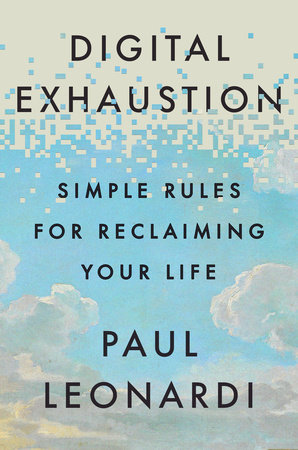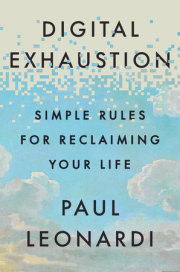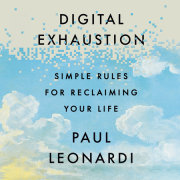Chapter 1Attention:You Really Do Pay with It
Maya is jolted awake at 5:50 a.m. by the buzzing in her right ear. The buzz and the light accompanying it emanate from her smartphone, which sits on her nightstand, inches from her resting head. She grabs her phone, turns off the alarm, and looks at the time. As on most mornings, she groans and flops the phone back down on her nightstand. But seconds later, even though she is still half asleep, she instinctively reaches for it, enters her passcode, and taps the icon for the Instagram app. She spends several minutes scrolling through pictures posted by her friends and family members-as well as strangers she's never met-before a notification pops up alerting her that she's received an email from The New York Times previewing the day's top news stories. She clicks on the notification, which opens her email application. Before she can even look at the Times, she notices several emails that arrived from colleagues in Europe while she was sleeping. She clicks on the first one and begins to read it while her partner, who is lying on the other side of the bed, groans something she doesn't hear. She's about to ask him what he said, when the "do not disturb" mode she set on her phone turns off and she sees she has three text messages and one WhatsApp message. She clicks on one of the texts, but before she reads it, she thinks perhaps the WhatsApp message might be more important, so she switches to that app. It turns out it's just a group message from some friends overseas. So she switches back to her texts and reads one from a close friend asking her if she can believe the recent Supreme Court ruling. Her partner grumbles something again, and Maya still doesn't hear what he wants because she's too busy clicking on the New York Times app to see what news she can find about the Supreme Court. "Shit," she says as she notices the time (Maya tells me she makes this exclamation just about every morning). She hops out of bed, turns on the shower, and just as she's ready to step under the warm water she finally hears what her partner is asking on his third attempt to get her attention: "Hey, Maya, do you know where my phone is?"
Maya's story could be my story, your story, or anyone's, really. There's hardly a moment in the day that's free from some news source, application, or digital device trying to catch our attention. We live in an attention economy. Our attention is valuable because it's a limited resource that companies can monetize. Maya knows that if she clicks on one of the ads for Skims exercise clothing that seem to have overtaken her Instagram feed, Kim Kardashian's company will pay Instagram a small fee for the referral. But what she and most other people don't fully appreciate is that there is an entire set of lucrative economic transactions that don't depend on whether we click on an ad; the owners of the website or application are getting paid if they can provide proof that we simply saw the ad. This is what the world of digital marketing refers to as "impressions." If Instagram or The New York Times or any other commercial website can show advertisers that people like you and me are likely to stay on their site for a long time, they can charge more for the ad placement because more time on the site means a higher probability of the ad making an impression on you. From the moment you wake up, the attention merchants are angling for you.
But it's not all about money. Those emails from work colleagues in Europe and the texts from friends are also vying for your attention. So is that voice coming from the other side of the bed. We receive and send so many texts and emails (and have to call from the other side of the bed multiple times) because we know that other people's attention is limited and we are fighting to get a piece of it. And the data show that inundating people works. One of the first research studies I conducted was with project managers from six different companies. Project managers often have the unenviable task of trying to coordinate people and get them to do things without having direct reporting authority over them. That means they are in a constant battle to grab and hold people's attention. We found that project managers who were the most successful in moving their projects forward on time and on budget were those who sent the same message to people on their team multiple times through different technologies. They would email, call, and walk by colleagues' desks to tell them the same thing three times through three distinct media. And it worked. Project managers who engaged in this kind of redundant communication were able to cut through the various demands on others' limited cognition and capture their attention more often than those who refrained from launching similar assaults on people's attention. Unfortunately, the project managers in our study eventually realized what you and I have come to learn the hard way: Over time, all their extra communicating added to the amount of data that those they were trying to reach had to process, leading them to feel more distracted and making it even harder to capture their attention.
The predicament that most people find themselves in today is now well-documented. Our attention is fragmented. We lose focus and become easily distracted. We can't get things done as quickly or as easily as we should be able to, and often quality suffers. More insidiously, the multiple demands on our attention shape not only whether we can pay attention but also how we pay attention. As Nicholas Carr eloquently described in The Shallows: What the Internet Is Doing to Our Brains, one of the first books to document how the internet is changing patterns of attention: "Media aren't just channels of information. They supply the stuff of thought, but they also shape the process of thought. And what the Net seems to be doing is chipping away my capacity for concentration and contemplation. Whether I'm online or not, my mind now expects to take in information the way the Net distributes it: in a swiftly moving stream of particles. Once I was a scuba diver in the sea of words. Now I zip along the surface like a guy on a Jet Ski."
Since Carr published his important book fifteen years ago, our attention has undoubtedly become more fragmented as more companies and more people try to find ways to capture it. Several important books have appeared in the last few years to help us figure out how to redirect our attention. Cal Newport, author of Digital Minimalism, exhorts us to dampen the assaults on our attention so we can do "deep work," and Johann Hari, author of Stolen Focus, urges us to find ways to reclaim our focus so we can "think deeply again." In this chapter, I take a slightly different approach. Rather than tell you that you should pay better attention so that you are not so exhausted, I'm going to show you how paying attention is itself exhausting.
How We Pay Attention Matters
Maya's preshower routine is familiar to most of us. According to a major national study conducted in 2010, 65 percent of American adults reported that they routinely slept with their smartphone on or right next to their beds. By 2023, researchers had stopped asking if people slept with their phones next to the bed and were instead asking if they slept with them in bed. Sixty percent of adults admitted to doing so, and a whopping 89 percent reported that they checked their phones within the first ten minutes of waking up. Were Maya and the rest of us just glancing at the time or waking up to read one article on our phone, these stats might seem unremarkable. The real cause for concern is that we mercilessly divide our attention across so many different and incommensurate information inputs that we are literally fatiguing our brains from the moment we wake up.
A long line of research in brain science shows that the human brain is not made to do multiple things at once. When we are confronted with a new piece of information or start some new task, blood rushes to our anterior prefrontal cortex, which is like our brain's command center. This command center sounds a two-tone alarm that we need to switch our attention: The first begins a search process for neurons capable of making sense of the information or doing the task. The second sends a command that will tell those neurons what to do. This process is called "task rule activation," and it only takes a few tenths of a second to unfold. When some new stimulus demands our attention, the brain must disengage from the first task-reading the news-to begin the second-checking our text messages. The command center tells the brain that another attention switch is going to happen and sends another two-tone alarm, starting another rule activation protocol. What's remarkable is the consistency with which this process unfolds. This process occurs in the same sequence every time we switch our attention from one input to another.
Here's why that matters. Each time we are exposed to a new stimulus and engage in the sequential process of disconnecting and reallocating our attention, we are expending valuable metabolic energy. Our brain makes up around 2 percent of our body mass but burns roughly 20 percent of the calories we ingest daily. Most of that energy expenditure is devoted to controlling our bodies; the brain reserves very little energy to power its own active cognition. As neurologist Richard Cytowic notes, "Precisely because it is so efficient, [our brain's] reserve margins are slim and quickly eaten up by the demands made by constantly shifting attention."
Each switch in attention is a costly energy expenditure. And the exhaustion from each successive switch adds up cumulatively. Think about running short sprints. You run as fast as you can for ten seconds, you cover 200 feet, and you feel tired. But you have enough energy to do it again. You rest for a minute, then sprint for ten more seconds, but this time you only cover 180 feet. Of course, the longer you rest between sprints, the more the results of your second attempt will look like your first. But if you don't rest at all, you may only be able to cover 100 feet on your second attempt. That's exactly what happens in our brains. The more we switch our attention, the harder it becomes to attend to anything because the brain grows increasingly tired. After too much switching in too short a period, it's hard to sustain attention at all because our brain is exhausted. Since it uses only a small reserve of its entire energy for cognitive processing, the rest of our body might not feel exhausted, but our brain is worn out. And that's a feeling that impacts us deeply.
Cognitive scientists give these dramatic shifts in our attention the name "context switching." When we need to switch contexts, our brain must disengage from the cognitive processes related to the initial task and reorient itself to the demands of the next task. If we switch from looking at one TikTok video about cute hairstyles to another about fashionable shoes, we don't actually shift our attention in the technical sense of activating the command center in our prefrontal cortex and getting new neurons firing. It's when we switch between contexts that demand new and different kinds of cognitive processing to make sense of information or perform some operation that the process of disconnecting and reconnecting discussed earlier occurs and our brain's limited energy is discharged. Context switching also releases cortisol to give a burst of energy to power through the transition. That cortisol release comes with a nasty side effect: Short energy bursts from the stress hormone accumulate into cognitive exhaustion. Not all context switches are the same, and thus the different ways that we shift our attention exhaust us differently. I find there are three types of context switches that are the most common and the biggest taxers on our cognitive energy reserves: switches between modalities, domains, and arenas.
Why Do You Have So Many Apps Open?
A modality is a particular mode in which something exists or is experienced. At the most basic level, our senses-seeing, hearing, touching, tasting, and smelling-are modalities. If we could isolate our senses from one another, we would experience a stimulus, like a car passing in front of us while we're standing at a crosswalk, differently depending on which sense is activated. Once, I was standing at a crosswalk and some dust flew into my eye. While my eyes were closed for the fifteen seconds or so it took to rub them and coax the fleck of dust out, I could hear a car engine. When I opened my eyes, I was surprised to see that the car was right in front of me as I stood still in the crosswalk. Those few seconds of transition from sound to sight were jarring because I had to reorient to the world when perceiving it through a new modality. It wasn't hard to do, but it also wasn't automatic. Adjusting to experience a stimulus in different ways-via different modalities-takes work.
Devices-laptops, cell phones, smartwatches-are modalities. Software applications like LinkedIn, Facebook, Zillow, Zoom, and Microsoft Word are modalities too. Each device or application gives us different capabilities. They also look different and are formatted differently from one another. These differences matter. Ioana, who works as an educational consultant for K-12 schools, is often on several videoconferences a day with various school administrators around the country. The schools typically arrange the meetings with Ioana, and she uses their preferred videoconferencing platforms. In a single morning, she often has meetings with schools through Zoom, Microsoft Teams, Webex, and Google Meet. As Ioana recounts, "We primarily use Zoom at my company, so I'm the most comfortable with it. When I get on Teams or Webex, I'm just not as fluent. It takes me a minute to think about how to share my screen or change my background. You do those things differently on each application, so I get a bit stressed in the moment when I can't just do it as easily as I could on Zoom." Although it barely seems like a notable switch to move between applications of a similar type like Zoom and Teams, our experience on each of those platforms is unique because we need to readjust to their layouts, colors, and buttons to be able to use them effectively. That readjustment is enough to cause us stress, and the cognitive expenditure and cortisol release of moving between different types of applications-from Gmail to your company's financial management platform to the ParentSquare application that sends notifications about your child's school-is even greater.
Copyright © 2025 by Paul Leonardi. All rights reserved. No part of this excerpt may be reproduced or reprinted without permission in writing from the publisher.










